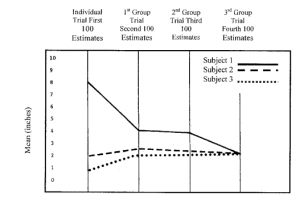Autokinetic effect and Social Norms
Autokinetic effect and conformity.
Muzafer Sherif is a Turkish American social psychologist. He conducted a classic experiment on social norm and conformity, testing subjects to watch a pinpoint of light and report how far it moved. Autokinetic effect is a visual phenomenon where a stationary light in a dark room appears to move. A probably reason is that we perceive distances and motion relative to some reference point. In a dark environment, no reference point is in sight, so the motion of a single light in undefined. Many people believe that a pinpoint light moves even when it does not.
Sherif uses this phenomena to study how people are influenced by other people opinion. The experiment has 2 phases.
In phase 1, he studies the reactions of auto kinetic effect individually and recorded each individuals norm. In the end, many people settled on the distance of 2 to 6 inches from trial to trial.
In phase 2, groups of subjects of 2 or 3 where formed and placed in the dark room and came to an agreement.
People who estimated 6 inches began to conform to smaller distances such as 4 inches and people who estimated less than 3 inches increase their judgement to 5 inches. This shows that people change their distances rather than keep to their own observation in the presence of other opinions.
Afterwards, Sherif repeated phase 1 and to his surprise, they now conform that light is moving about 4 inches whether they know that they were influenced or not. Group norms appear to establish through levelling off extreme opinions.
This shows that the group norm influence is greater than the individual norms. What this means is that in the long run, for a group norm to change, there has to be a greater number of subjects to be able to affect the group norm’s opinion.
Citations:
http://www.integratedsociopsychology.net/Conformity-Majority_Influence/MuzaferSherif’suseofautokineticeffectfor.html

